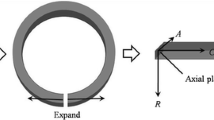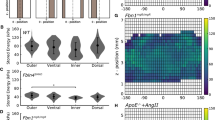Abstract
Data relating to residual deformations in human arteries are scarce. In this paper we investigate three-dimensional residual deformations for intact strips and for their separate layers from human aortas in their passive state. From 11 abdominal aortas with identified anamnesis, 16 pairs of rings and axial strips were harvested, and the rings cut open. After 16 h images of the resulting geometries were recorded, and the strips were separated into their three layers; after another 6 h images were again recorded. Image processing and analysis was then used to quantify residual stretches and curvatures. For each specimen histological analysis established that the intima, media and adventitia were clearly separated, and the separation was atraumatic. Axial in situ stretches were determined to be 1.196 ± 0.084. On separation, the strips from the adventitia and media shortened (between 4.03 and 8.76% on average), while the intimal strips elongated on average by 3.84% (circumferential) and 4.28% (axial) relative to the associated intact strips. After separation, the adventitia from the ring sprang open by about 180° on average, becoming flat, the intima opened only slightly, but the media sprang open by more than 180° (as did the intact strip). The adventitia and intima from the axial strips remained flat, while the media (and the intact strip) bent away from the vessel axis. This study has shown that residual deformations are three dimensional and cannot be described by a single parameter such as ‘the’ opening angle. Their quantification and modeling therefore require consideration of both stretching and bending, which are highly layer-specific and axially dependent.














Similar content being viewed by others
References
Badrek-Amoudi A., Patel C. K., Kane T. P. C., Greenwald S. E. (1996) The effect of age on residual strain in the rat aorta. J. Biomech. Eng. 118:440–444
Bergel, D. H. The visco-elastic properties of the arterial wall. Ph.D. thesis, University of London, 1960.
Bergel, D. H. The properties of blood vessels. In: Fung Y. C., Perrone N., Anliker M. (eds) Biomechanics: Its Foundations and Objectives. Prentice-Hall, Englewood Cliffs, New Jersey, pp 105–139, 1972.
Cabrera Fischer E. I., Bia D., Camus J. M., Zocalo Z., Forteza E., Armentano R. L. (2006) Adventitia-dependent mechanical properties of brachiocephalic ovine arteries in in vivo and in vitro studies. Acta Physiol. 188:103–111
Chuong C. J., Fung Y. C. (1983) Three-dimensional stress distribution in arteries. J. Biomech. Eng. 105:268–274
Chuong C. J., Fung Y. C. (1986) On residual stress in arteries. J. Biomech. Eng. 108:189–192
Cox R. H. (1974) Three-dimensional mechanics of arterial segments in vitro: Methods. J. Appl. Phys. 36:381–384
Dobrin, P. B. Vascular mechanics. In: Shepherd J. T., Abboud F. M. (eds) Handbook of Physiology Section 2: The Cardiovascular System, volume III. American Physiological Society, Bethesda, pp 65–102, 1983.
Fung Y. C., Fronek K., Patitucci P. (1979) Pseudoelasticity of arteries and the choice of its mathematical expression. Am. J. Physiol. 237:H620–H631
Fung Y.C. (1983) On the foundations of biomechanics. J. Appl. Mech. 50:1003–1009
Fung Y. C., Liu S. Q. (1989) Change of residual strains in arteries due to hypertrophy caused by aortic constrictions. Circ. Res. 65:1340–1349
Fung Y. C., Liu S. Q. (1989) Relationship between hypertension, hypertrophy, and opening angle of zero-stress state of arteries following aortic constriction. J. Biomech. Eng. 111:325–335
Fung, Y. C. and S. Q. Liu. Strain distribution in small blood vessels with zero-stress state taken into consideration. Am. J. Physiol. H544–H552, 1992.
Gonzalez R. C., Woods R. E. (1992) Digital Image Processing. Addison Wesley, New York
Greenwald S. E., Moore J. E. Jr., Rachev A., Kane T. P. C., Meister J.-J. (1997) Experimental investigation of the distribution of residual strains in the artery wall. J. Biomech. Eng. 119:438–444
Holzapfel G. A., Gasser T. C., Ogden R. W. (2000) A new constitutive framework for arterial wall mechanics and a comparative study of material models. J. Elasticity 61:1–48
Holzapfel G. A., Gasser T. C., Ogden R. W. (2004) Comparison of a multi-layer structural model for arterial walls with a Fung-type model, and issues of material stability. J. Biomech. Eng. 126:264–275
Holzapfel, G. A. and R. W. Ogden (eds). Mechanics of Biological Tissue. Springer-Verlag, Heidelberg, 2006.
Holzapfel G. A., Sommer G., Gasser C. T., and Regitnig P. (2005) Determination of the layer-specific mechanical properties of human coronary arteries with non-atherosclerotic intimal thickening, and related constitutive modelling. Am. J. Physiol. Heart Circ. Physiol. 289:H2048–H2058
Humphrey J. D. (2002) Cardiovascular Solid Mechanics. Cells, Tissues, and Organs. Springer-Verlag, New York
Humphrey J. D., Yin F. C. P. (1989) Constitutive relations and finite deformations of passive cardiac tissue: II. Stress analysis in the left ventricle. Circ. Res. 65:805–817
Liu S.Q., Fung Y.C. (1988) Zero-stress states of arteries. J. Biomech. Eng. 110:82–84
Lohn M., Dubrovska G., Lauterbach B., Luft F. C., Gollasch M., Sharma A. M. (2002) Periadventitial fat releases a vascular relaxing factor. FASEB J. 16:1057–1063
Matsumoto T., Hayashi K. (1996) Stress and strain distribution in hypertensive and normotensive rat aorta considering residual strain. J. Biomech. 118:62–73
Matsumoto T., Hayashi K., Ide K. (1995) Residual strain and local strain distributions in the rabbit atherosclerotic aorta. J. Biomech. 28:1207–1217
von Maltzahn W.-W., Warriyar R. G., Keitzer W. F. (1984) Experimental measurements of elastic properties of media and adventitia of bovine carotid arteries. J. Biomech. 17:839–847
McDonald D. A. (1974) Bloodflow in Arteries. Edward Arnold, London
Nichols W. W., O’Rourke M. F. (1998) McDonald’s Blood Flow in Arteries. Theoretical, Experimental and Clinical Principles, Chapter 4, 4th edition. Arnold, London, pp. 73–97.
Ogden, R. W. and C. A. J. Schulze-Bauer. Phenomenological and structural aspects of the mechanical response of arteries. In: Mechanics in Biology, edited by J. Casey, and G. Bao. New York: The American Society of Mechanical Engineers (ASME), AMD-Vol. 242/BED-Vol. 46, 2000, pp. 125–140.
Patel D. J., Vaishnav R. N. (1980) Basic Hemodynamics and its Role in Disease Processes. University Park Press, Baltimore
Rachev A., Greenwald S. E. (2003) Residual strains in conduit arteries. J. Biomech. 36:661–670
Saini A., Berry C., Greenwald S. (1995) Effect of age and sex on residual stress in the aorta. J. Vasc. Res. 32:398–405
Schulze-Bauer C. A. J., Mörth C., Holzapfel G. A. (2003) Passive biaxial mechanical response of aged human iliac arteries. J. Biomech. Eng. 125:395–406
Schulze-Bauer C. A. J., Regitnig P., Holzapfel G. A. (2002) Mechanics of the human femoral adventitia including high-pressure response. Am. J. Physiol. Heart Circ. Physiol. 282:H2427–H2440
Stary H. C. (2003) Atlas of Atherosclerosis: Progression and Regression, 2nd edition The Parthenon Publishing Group Limited, Boca Raton, London, New York, Washington, DC
Stary, H. C., D. H. Blankenhorn, A. B. Chandler, S. Glagov, W. Insull, Jr., M. Richardson, M. E. Rosenfeld, S. A. Schaffer, C. J. Schwartz, W. D. Wagner, and R. W. Wissler. A definition of the intima of human arteries and of its atherosclerosis-prone regions. A report from the committee on vascular lesions of the council on arteriosclerosis, american heart association. Circulation 85:391–405, 1992.
Takamizawa K., Hayashi K. (1987) Strain energy density function and uniform strain hypothesis for arterial mechanics. J. Biomech. 20:7–17
Takamizawa K., Hayashi K. (1988) Uniform strain hypothesis and thin-walled theory in arterial mechanics. Biorheology 25:555–565
Vaishnav R. N., Vossoughi J. (1983) Estimation of residual strains in aortic segments. In: Hall C. W. (ed.) Biomedical Engineering II: Recent Developments. Pergamon Press, New York, pp 330–333
Vito R. P. (1973) A note on arterial elasticity. J. Biomech. 6:561–564
Vossoughi, J. Longitudinal residual strains in arteries. In: Proceedings of the 11th Southern Biomedical Engineering Conference, Memphis, TN, 1992. October 2–4, 1992, pp. 17–19.
Vossoughi, J., Z. Hedjazi, and F. S. Borris. Intimal residual stress and strain in large arteries. In: Proceedings of the Summer Bioengineering Conference, edited by N. A. Langrana, M. H. Friedman, and E. S. Groods. New York: ASME, 1993, pp. 434–437.
Weizsäcker H. W., Lambert H., Pascale K. (1983) Analysis of the passive mechanical properties of rat carotid arteries. J. Biomech. 16:703–715
Weizsäcker H. W., Pinto J. G. (1988) Isotropy and anisotropy of the arterial wall. J. Biomech. 21:477–487
Acknowledgments
The authors are indebted to the late C.A.J. Schulze-Bauer and to E. Pernkopf, who helped to initiate the early part of this work and made substantial contributions to the experiments. Financial support for this research was partly provided by the ‘Fonds zur Fortsetzung Christian’s Forschung’, the Austrian Science Foundation under START-Award Y74-TEC and by the Oesterreichische Nationalbank (OeNB) project 9190. These supports are gratefully acknowledged.
Author information
Authors and Affiliations
Corresponding author
Rights and permissions
About this article
Cite this article
Holzapfel, G.A., Sommer, G., Auer, M. et al. Layer-Specific 3D Residual Deformations of Human Aortas with Non-Atherosclerotic Intimal Thickening. Ann Biomed Eng 35, 530–545 (2007). https://doi.org/10.1007/s10439-006-9252-z
Received:
Accepted:
Published:
Issue Date:
DOI: https://doi.org/10.1007/s10439-006-9252-z




